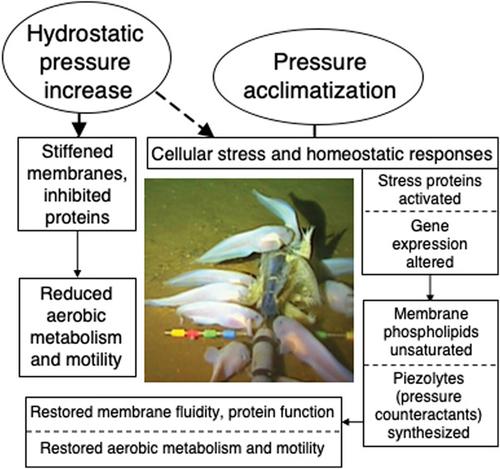当前位置:
X-MOL 学术
›
J. Exp. Zool. Part A
›
论文详情
Our official English website, www.x-mol.net, welcomes your
feedback! (Note: you will need to create a separate account there.)
Cellular responses in marine animals to hydrostatic pressure.
Journal of Experimental Zoology Part A ( IF 1.9 ) Pub Date : 2020-02-24 , DOI: 10.1002/jez.2354 Paul H Yancey 1
Journal of Experimental Zoology Part A ( IF 1.9 ) Pub Date : 2020-02-24 , DOI: 10.1002/jez.2354 Paul H Yancey 1
Affiliation

|
Hydrostatic pressure (HP), increasing by 1 atm per 10 m in the ocean, perturbs many cellular processes, for example, by rigidifying membranes and disturbing protein folding and ligand binding. Membranes can be fluidized to work under high HP by increasing unsaturated fatty acids, for example, docosahexaenoic acid. Over generations, some deep‐sea proteins have evolved intrinsic resistance to HP, but often incompletely. These may be protected from HP with piezolytes, small organic molecules with pressure‐counteracting properties. The key example is the osmolyte trimethylamine N‐oxide (TMAO), which marine fishes and crustaceans accumulates linearly with depth. TMAO can effectively counteract many inhibitory effects of HP on numerous proteins. For short‐term HP stress, cellular stress (transient) and homeostasis (persistent) responses (CSRs, CHRs) remain poorly characterized, but across different taxa of shallow and terrestrial organisms, they include common CSR/CHR mechanisms known for other stressors—heat shock proteins (HSPs), boosted energy metabolism, antioxidants, cellular repair systems. For vertically migrating marine animals, HP stress responses are even more poorly characterized. Some species (e.g., Anguilla silver eel, king crab Lithodes maja, snubnosed eel Simenchelys parasiticus) cope with HP changes in their habitat range by intrinsic adaptations, lipid desaturase activation, and metabolic adjustments, but perhaps not common CSR mechanisms. Such species may have constitutive stress proteins and/or are able to adjust membrane saturation and/or TMAO rapidly with depth. For permanent deep‐sea species, CSR/CHR mechanisms have not been directly tested, but evidence in Mariana Trench amphipods and snailfish suggest that HSP and desaturase genes, and possibly piezolyte synthesis, have undergone habitat‐related selection.
中文翻译:

海洋动物对静水压力的细胞反应。
海洋中的静水压力(HP)每10 m增加1 atm,它例如通过使膜变硬并干扰蛋白质折叠和配体结合来扰乱许多细胞过程。通过增加不饱和脂肪酸(例如二十二碳六烯酸),可以使膜流化以在高HP下工作。几代人以来,一些深海蛋白质已经进化出了对HP的内在抗性,但往往不完全。这些可以通过压电电解质保护免受HP损害,具有抗压力特性的有机小分子。关键示例是渗透液三甲胺N-氧化物(TMAO),海水鱼类和甲壳类动物随深度线性积累。TMAO可以有效抵消HP对多种蛋白质的多种抑制作用。对于短期HP应激,细胞应激(瞬时)和体内稳态(持续)反应(CSR,CHR)的特征仍然较差,但是在浅层和陆地生物的不同分类单元中,它们包括其他应激源(热)已知的常见CSR / CHR机制休克蛋白(HSP),促进能量代谢,抗氧化剂,细胞修复系统。对于垂直迁移的海洋动物,HP应激反应的特征甚至更差。一些种类(例如,安圭拉银鳗,帝王蟹Lithodes maja,冷淡的鳗鱼Simenchelys parasiticus)通过内在适应,脂质去饱和酶活化和代谢调节来应对其栖息地范围内的HP变化,但也许不是常见的CSR机制。这样的物种可以具有组成性应激蛋白和/或能够随深度快速调节膜饱和度和/或TMAO。对于永久性深海物种,尚未直接测试CSR / CHR机制,但是马里亚纳海沟的两栖动物和蜗牛鱼中的证据表明HSP和去饱和酶基因以及可能的压电电解质合成已经历了与生境有关的选择。
更新日期:2020-02-24
中文翻译:

海洋动物对静水压力的细胞反应。
海洋中的静水压力(HP)每10 m增加1 atm,它例如通过使膜变硬并干扰蛋白质折叠和配体结合来扰乱许多细胞过程。通过增加不饱和脂肪酸(例如二十二碳六烯酸),可以使膜流化以在高HP下工作。几代人以来,一些深海蛋白质已经进化出了对HP的内在抗性,但往往不完全。这些可以通过压电电解质保护免受HP损害,具有抗压力特性的有机小分子。关键示例是渗透液三甲胺N-氧化物(TMAO),海水鱼类和甲壳类动物随深度线性积累。TMAO可以有效抵消HP对多种蛋白质的多种抑制作用。对于短期HP应激,细胞应激(瞬时)和体内稳态(持续)反应(CSR,CHR)的特征仍然较差,但是在浅层和陆地生物的不同分类单元中,它们包括其他应激源(热)已知的常见CSR / CHR机制休克蛋白(HSP),促进能量代谢,抗氧化剂,细胞修复系统。对于垂直迁移的海洋动物,HP应激反应的特征甚至更差。一些种类(例如,安圭拉银鳗,帝王蟹Lithodes maja,冷淡的鳗鱼Simenchelys parasiticus)通过内在适应,脂质去饱和酶活化和代谢调节来应对其栖息地范围内的HP变化,但也许不是常见的CSR机制。这样的物种可以具有组成性应激蛋白和/或能够随深度快速调节膜饱和度和/或TMAO。对于永久性深海物种,尚未直接测试CSR / CHR机制,但是马里亚纳海沟的两栖动物和蜗牛鱼中的证据表明HSP和去饱和酶基因以及可能的压电电解质合成已经历了与生境有关的选择。











































 京公网安备 11010802027423号
京公网安备 11010802027423号